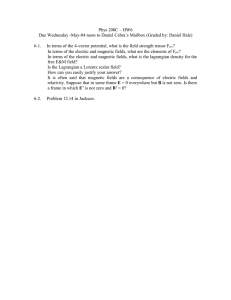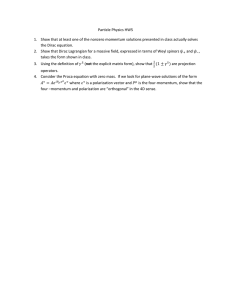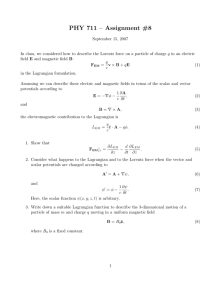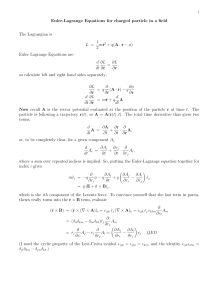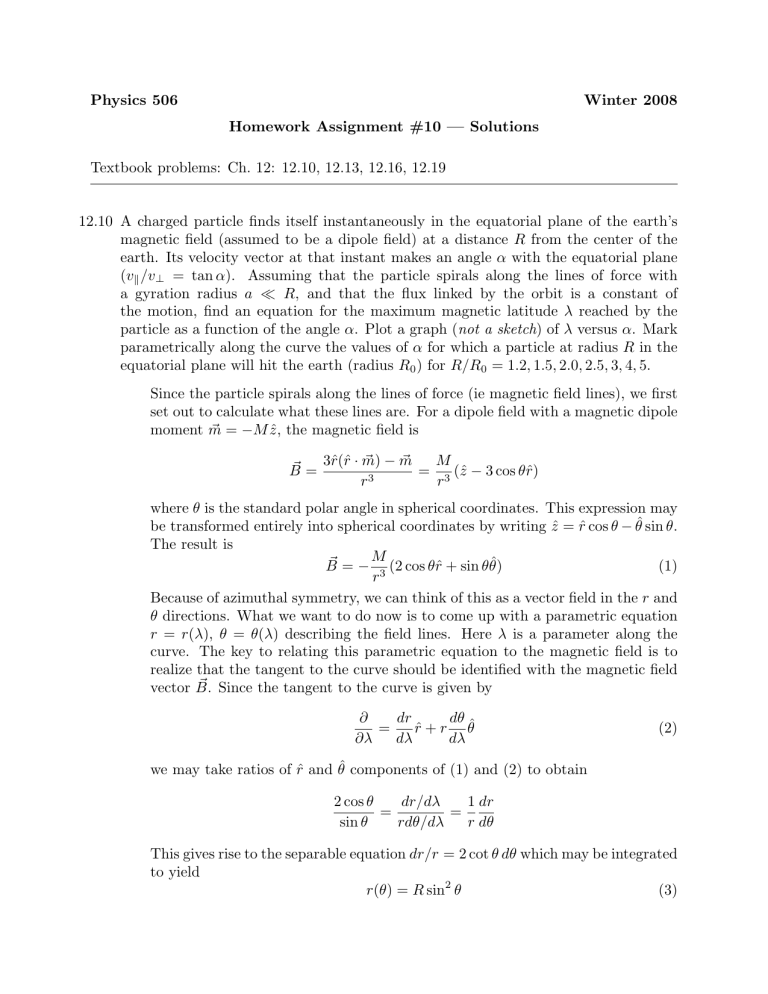
Physics 506 Winter 2008 Homework Assignment #10 — Solutions Textbook problems: Ch. 12: 12.10, 12.13, 12.16, 12.19 12.10 A charged particle finds itself instantaneously in the equatorial plane of the earth’s magnetic field (assumed to be a dipole field) at a distance R from the center of the earth. Its velocity vector at that instant makes an angle α with the equatorial plane (vk /v⊥ = tan α). Assuming that the particle spirals along the lines of force with a gyration radius a R, and that the flux linked by the orbit is a constant of the motion, find an equation for the maximum magnetic latitude λ reached by the particle as a function of the angle α. Plot a graph (not a sketch) of λ versus α. Mark parametrically along the curve the values of α for which a particle at radius R in the equatorial plane will hit the earth (radius R0 ) for R/R0 = 1.2, 1.5, 2.0, 2.5, 3, 4, 5. Since the particle spirals along the lines of force (ie magnetic field lines), we first set out to calculate what these lines are. For a dipole field with a magnetic dipole moment m ~ = −M ẑ, the magnetic field is ~ −m ~ M ~ = 3r̂(r̂ · m) B = 3 (ẑ − 3 cos θr̂) 3 r r where θ is the standard polar angle in spherical coordinates. This expression may be transformed entirely into spherical coordinates by writing ẑ = r̂ cos θ − θ̂ sin θ. The result is ~ = − M (2 cos θr̂ + sin θθ̂) B (1) r3 Because of azimuthal symmetry, we can think of this as a vector field in the r and θ directions. What we want to do now is to come up with a parametric equation r = r(λ), θ = θ(λ) describing the field lines. Here λ is a parameter along the curve. The key to relating this parametric equation to the magnetic field is to realize that the tangent to the curve should be identified with the magnetic field ~ Since the tangent to the curve is given by vector B. dr dθ ∂ = r̂ + r θ̂ ∂λ dλ dλ (2) we may take ratios of r̂ and θ̂ components of (1) and (2) to obtain 2 cos θ dr/dλ 1 dr = = sin θ rdθ/dλ r dθ This gives rise to the separable equation dr/r = 2 cot θ dθ which may be integrated to yield r(θ) = R sin2 θ (3) Note that we have chosen the initial condition that r(π/2) = R, since θ = π/2 corresponds to the equatorial plane. In addition to the equation for a magnetic field line, we also need the magnitude of the magnetic field. This may be computed from (1) √ M 1 + 3 cos2 θ B= r3 Along the line r = R sin2 θ, this becomes M B(θ) = 3 R √ 1 + 3 cos2 θ sin6 θ (4) Since the flux linked by the orbit is a constant of motion (an adiabatic invariant), we end up with the velocity relation 2 vk (θ) = v02 − 2 B(θ) v⊥,0 B0 = 2 vk,0 + 2 v⊥,0 B(θ) 1− B0 2 2 where we have used v02 = vk,0 + v⊥,0 . The particle starts at an angle θ0 = π/2. From (4), the initial magnetic field is B0 = M/R3 . hence √ 2 vk (θ) = 2 vk,0 + 2 v⊥,0 1− 1 + 3 cos2 θ sin6 θ ! The minimum value of θ is reached at the turning point when vk (θ) = 0. This corresponds to √ 2 vk,0 + 2 v⊥,0 1− 1 + 3 cos2 θ sin6 θ √ ! =0 ⇒ 2 vk,0 1 + 3 cos2 θ = 1 + 2 v⊥,0 sin6 θ Setting θ = π/2 − λ where λ is the magnetic latitude, and using vk,0 /v⊥,0 = tan α then gives p 1 + 3 sin2 λ 1 + tan2 α = cos6 λ or p !1/2 2 1 + 3 sin λ −1 α = tan−1 cos6 λ We may plot λ versus α as λ 80 60 R /R 0 40 1.2 4 5 2.5 3 1.5 2.0 20 20 40 60 80 α Since the magnetic field line is given by p (3), the particle will hit the earth when R0 = R sin2 θ = R cos2 λ, or λ = cos−1 R0 /R. These values are indicated on the plot. 12.13 a) Specialize the Darwin Lagrangian (12.82) to the interaction of two charged particles (m1 , q1 ) and (m2 , q2 ). Introduce reduced particle coordinates, ~r = ~x1 − ~x2 , ~v = ~v1 − ~v2 and also center of mass coordinates. Write out the Lagrangian in the reference frame in which the velocity of the center of mass vanishes and evaluate the canonical momentum components, px = ∂L/∂vx , etc. The two particle Darwin Lagrangian reads L= 1 1 1 q1 q1 q2 m1 v12 + m2 v22 + 2 (m1 v14 +m2 v24 )− r12 + [~v1 ·~v2 +(~v1 ·r̂)(~v2 ·r̂)] (5) 2 2 8c q2 2r12 c2 We take a standard (non-relativistic) transformation to center of mass coordinates ~r = ~x1 − ~x2 , ~ = m1 ~x1 + m2 ~x2 R M where M = m1 + m2 . Inverting this gives ~+ ~x1 = R m2 ~r, M ~− ~x2 = R m1 ~r M As a result, the individual terms in the Lagrangian (5) become 1 1 1 1 m1 v12 + m2 v22 = M V 2 + µv 2 2 2 2 2 4 4 (m1 v1 + m2 v2 ) 1 m2 − m1 ~ m31 + m32 4 4 2 2 2 = 2 M V + 6µV v + 4µ (V · ~v )v + µ v 8c2 8c M M3 m2 − m1 ~ µ 2 ~v1 · ~v2 = V 2 + V · ~v − v M M ~ · r̂)2 + m2 − m1 (V ~ · r̂)(~v · r̂) − µ (~v · r̂)2 (~v1 · r̂)(~v2 · r̂) = (V M M where µ = m1 m2 /M is the reduced mass. For vanishing center of mass velocity ~ = 0) the Lagrangian becomes (V L= 1 2 1 m3 + m3 q1 q2 µq1 q2 2 [v + (~v · r̂)2 ] µv + 2 µ 1 3 2 v 4 − − 2 8c M r 2M rc2 (6) The canonical momentum is pi = ∂L/∂vi , which gives p~ = µ~v + µq1 q2 1 m31 + m32 2 µ v ~v − [~v + (~v · r̂)r̂] 2 3 2c M 2M rc2 (7) b) Calculate the Hamiltonian to first order in 1/c2 and show that it is 2 1 p2 1 q1 q2 p4 1 1 q1 q2 p + (~ p · r̂)2 H= + − 2 + + 3 + 2 m1 m2 r 8c m31 m2 2m1 m2 c2 r [You may disregard the comparison with Bethe and Salpeter.] The Hamiltonian is obtained from the Lagrangian (6) by the transformation H = p~ ·~v −L. Note, however, that we must invert the relation (7) to write the resulting H as a function of p~ and ~r. We start with 1 2 1 m31 + m32 4 q1 q2 µq1 q2 2 H = p~ · ~v − µv − 2 µ v + + [v + (~v · r̂)2 ] 3 2 2 8c M r 2M rc (8) 3 3 1 1 m + m q µq1 q2 2 p2 1 q2 1 2 4 2 2 − (~ p − µ~v ) − 2 µ v + + [v + (~v · r̂) ] = 2µ 2µ 8c M3 r 2M rc2 Since we only work to first order in 1/c2 , we do not need to completely solve (7) for ~v in terms of p~. Instead, it is sufficient to note that 1 1 ~v = p~ + O 2 µ c Inserting this into (8) gives (to order 1/c2 ) p2 1 m3 + m3 q1 q2 q1 q2 − 2 1 3 3 2 p4 + + [p2 + (~ p · r̂)2 ] 2µ 8c M µ r 2M µrc2 1 1 p4 1 1 q1 q2 q1 q2 p2 = + − 2 + 3 + + [p2 + (~ p · r̂)2 ] 3 2 m1 m2 8c m1 m2 r 2m1 m2 rc2 H= 12.16 a) Starting with the Proca Lagrangian density (12.91) and following the same procedure as for the electromagnetic fields, show that the symmetric stress-energymomentum tensor for the Proca fields is 1 1 αβ 1 αβ αβ αγ λβ λν 2 α β λ Θ = g Fγλ F + g Fλν F + µ A A − g Aλ A 4π 4 2 The Proca Lagrangian density is L=− 1 1 2 Fµν F µν + µ Aµ Aµ 16π 8π Since T µν = we find T µν = − ∂L ∂ ν Aλ − η µν L ∂∂µ Aλ 1 µλ ν 1 µν 2 1 2 µν 2 F ∂ Aλ + η F − µ η A 4π 16π 8π where we have used a shorthand notation F 2 ≡ Fµν F µν and A2 ≡ Aµ Aµ . In order to convert this canonical stress tensor to the symmetric stress tensor, we write ∂ ν Aλ = F ν λ + ∂λ Aν . Then 1 µλ ν 1 µλ [F F λ − 14 η µν F 2 + 21 µ2 η µν A2 ] − F ∂λ Aν 4π 4π 1 1 = − [F µλ F ν λ − 14 η µν F 2 + 21 µ2 η µν A2 − (∂λ F µλ )Aν ] − ∂λ (F µλ Aν ) 4π 4π T µν = − Using the Proca equation of motion ∂λ F λµ + µ2 Aµ = 0 then gives T µν = Θµν + ∂λ S λµν where Θµν = − 1 µλ ν F F λ − 41 η µν F 2 − µ2 (Aµ Aν − 12 η µν A2 ) 4π (9) is the symmetric stress tensor and S λµν = (1/4π)F λµ Aν is antisymmetric on the first two indices. b) For these fields in interaction with the external source J β , as in (12.91), show that the differential conservation laws take the same form as for the electromagnetic fields, namely Jλ F λβ ∂α Θαβ = c Taking a 4-divergence of the symmetric stress tensor (9) gives 1 ∂µ F µλ F ν λ + F µλ ∂µ F ν λ − 21 Fρλ ∂ ν F ρλ 4π − µ2 (∂µ Aµ Aν + Aµ ∂µ Aν − Aλ ∂ ν Aλ ) 1 =− ∂µ F µλ F ν λ + 12 Fρλ (2∂ ρ F νλ − ∂ ν F ρλ ) + µ2 Aλ (∂ ν Aλ − ∂λ Aν ) 4π 1 =− (∂µ F µλ + µ2 Aλ )F ν λ + 21 Fρλ (∂ ρ F νλ + ∂ λ F ρν + ∂ ν F λρ ) 4π 1 1 = − J λ F ν λ = Jλ F λν c c ∂µ Θµν = − Note that in the second line we have used the fact that ∂µ Aµ = 0, which is automatic for the Proca equation. To obtain the last line, we used the Bianchi identity 3∂ [ρ F νλ] = 0 as well as the Proca equation of motion. c) Show explicitly that the time-time and space-time components of Θαβ are 1 2 ~ · A)] ~ [E + B 2 + µ2 (A0 A0 + A 8π 1 ~ ~ i + µ2 Ai A0 ] [(E × B) = 4π Θ00 = Θi0 Given the explicit form of the Maxwell tensor, it is straightforward to show that F 2 ≡ Fµν F µν = −2(E 2 − B 2 ), ~2 A2 ≡ Aµ Aµ = (A0 )2 − A Thus Θµν = − i 1 h µλ ν ~ 2 )) F F λ + 12 η µν (E 2 − B 2 ) − µ2 (Aµ Aν − 21 η µν ((A0 )2 − A 4π The time-time component of this is Θ 00 i 1 h 0i 0 2 2 2 0 2 0 2 2 1 1 ~ =− F F i + 2 (E − B ) − µ ((A ) − 2 ((A ) − A )) 4π i 1 h 1 2 ~ 2) − 2 (E + B 2 ) − 12 µ2 ((A0 )2 + A =− 4π i 1 h 2 ~ 2) = E + B 2 + µ2 ((A0 )2 + A 8π Similarly, the time-space components are 1 4π 1 =− 4π Θ0i = − 0 ij 1 j F j F − µ2 A0 Ai = − E (−ijk B k ) − µ2 A0 Ai 4π i 1 h ~ j k 2 0 i i 2 0 i ~ −ijk E B − µ A A = (E × B) + µ A A 4π 12.19 Source-free electromagnetic fields exist in a localized region of space. Consider the various conservation laws that are contained in the integral of ∂α M αβγ = 0 over all space, where M αβγ is defined by (12.117). a) Show that when β and γ are both space indices conservation of the total field angular momentum follows. Note that M αβγ = Θαβ xγ − Θαγ xβ Hence M 0ij = Θ0i xj − Θ0j xi = c(g i xj − g j xi ) = cijk (~g × ~x )k = −cijk (~x × ~g )k where ~g is the linear momentum density of the electromagnetic field. Since ~x × ~g is the angular momentum density, integrating M 0ij over 3-space gives the field angular momentum Z Z ij 0ij 3 ijk (~x × ~g )k d3 x = −cijk Lk M ≡ M d x = −c The conservation law ∂µ M µij = 0 then corresponds to the conservation of angular momentum in the electromagnetic field. b) Show that when β = 0 the conservation law is ~ dX c2 P~em = dt Eem ~ is the coordinate of the center of mass of the electromagnetic fields, where X defined by Z Z 3 ~ X u d x = ~xu d3 x where u is the electromagnetic energy density and Eem and P~em are the total energy and momentum of the fields. In this case, we have Z Z 0i 00i 3 M ≡ M d x = (Θ00 xi − Θ0i x0 ) d3 x Z Z i i 0 3 = (ux − cg x ) d x = (uxi − c2 tg i ) d3 x Making use of the definition energy, we have simply R uxi d3 x = EX i where E = R u d3 x is the total field M 0i = EX i − c2 tP i R where P~ = ~g d3 x is the (linear) field momentum. Since M 0i is a conserved charge, its time derivative must vanish. This gives 0= ~ d ~ − c2 d (tP~ ) = E dX − c2 P~ (E X) dt dt dt (where we used the fact that energy and momentum are conserved, namely ~ dE/dt = 0 and dP~ /dt = 0). The result dX/dt = c2 P~ /E then follows.
